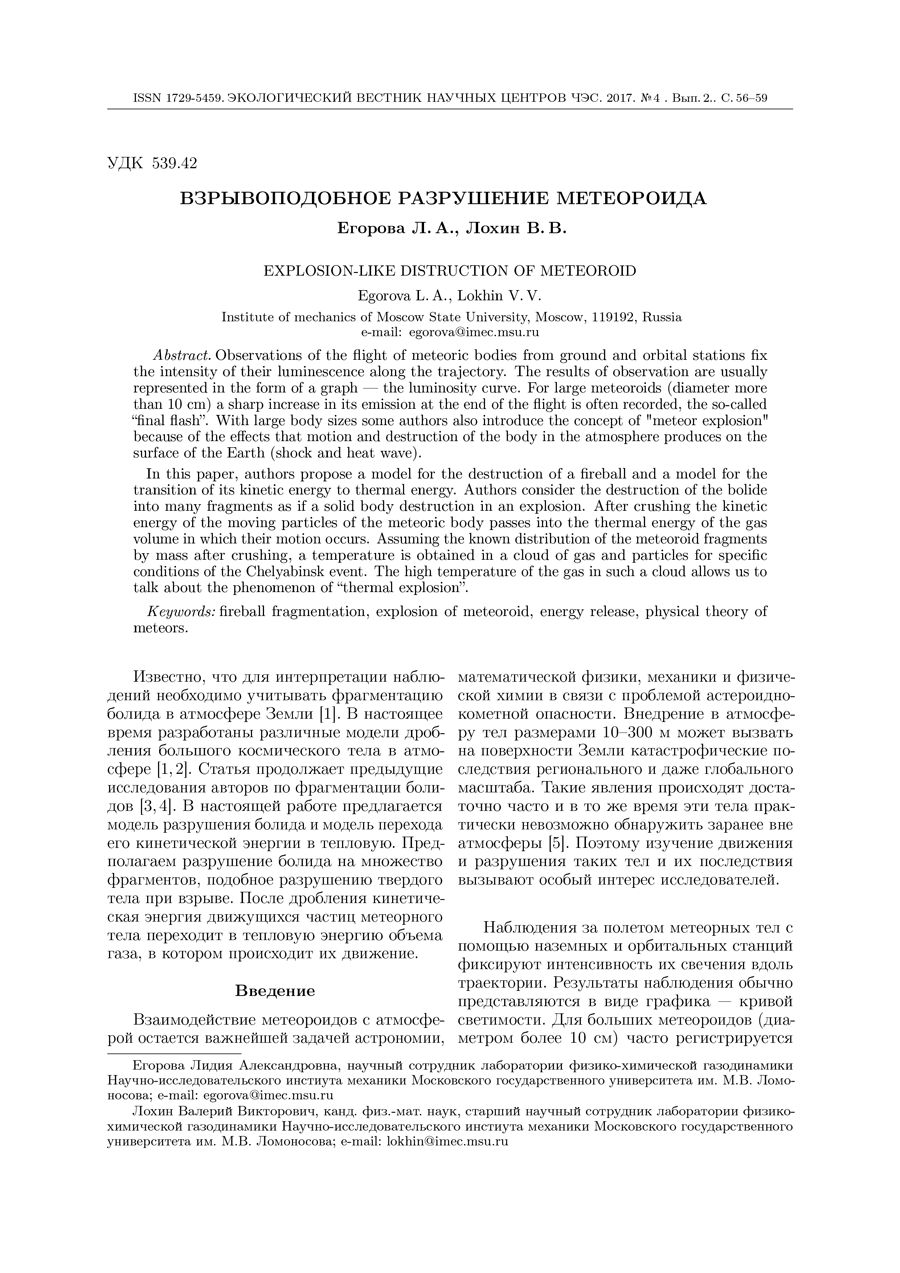Explosion-like distruction of meteoroid
UDC
539.42Abstract
Observations of the flight of meteoric bodies from ground and orbital stations fix the intensity of their luminescence along the trajectory. The results of observation are usually represented in the form of a graph — the luminosity curve. For large meteoroids (diameter more than 10 cm) a sharp increase in its emission at the end of the flight is often recorded, the so-called "final flash". With large body sizes some authors also introduce the concept of "meteor explosion" because of the effects that motion and destruction of the body in the atmosphere produces on the surface of the Earth (shock and heat wave). In this paper, authors propose a model for the destruction of a fireball and a model for the transition of its kinetic energy to thermal energy. Authors consider the destruction of the bolide into many fragments as if a solid body destruction in an explosion. After crushing the kinetic energy of the moving particles of the meteoric body passes into the thermal energy of the gas volume in which their motion occurs. Assuming the known distribution of the meteoroid fragments by mass after crushing, a temperature is obtained in a cloud of gas and particles for specific conditions of the Chelyabinsk event. The high temperature of the gas in such a cloud allows us to talk about the phenomenon of "thermal explosion".
Keywords:
fireball fragmentation, explosion of meteoroid, energy release, physical theory of meteorsReferences
- Popova O., Nemchinov I. Bolides in the Earth atmosphere. In: Catastrophic Events Caused by Cosmic Objects. Springer, Netherlands, 2008, pp. 131-162.
- Ceplecha Z., Revelle D.O. Fragmentation model of meteoroid motion, mass loss, and radiation in the atmosphere. Meteoritics & Planetary Science, 2005, vol. 40, no. 1, pp. 35-54.
- Egorova L., Lokhin V. On the mechanism of crushing meteoroid with end flash effect. EPSC. Moon and Planets, vol. 95, pp. 303-319.
- Egorova L.A., Lokhin V.V. Two-stage destruction of a meteoroid with a final burst. Moscow University Mechanics Bulletin, 2016, vol. 71, no. 4, pp. 82-86.
- Shuvalov V.V., Svettsov V.V., Trubetskaya I. A. An estimate for the size of the area of damage on the Earth's surface after impacts of 10-300-m asteroids. Solar System Research, 2013, vol. 47, no. 4, pp. 260-267.
- Register P.J., Mathias D.L., Wheeler L.F. Asteroid fragmentation approaches for modeling atmospheric energy deposition. Icarus, 2017, vol. 284, pp. 157-166.
- Nemchinov I. V., Popova O. P., Teterev A. V. Penetration of large meteoroids into the atmosphere: Theory and observations. Journal of Engineering Physics and Thermophysics, 1999, vol. 72, no. 6, pp. 1194-1223.
- Popova O. P. et al. Chelyabinsk airburst, damage assessment, meteorite recovery, and characterization. Science, 2013, vol. 342, no. 6162, pp. 1069-1073.
Downloads
Issue
Pages
Submitted
Published
How to Cite
Copyright (c) 2017 Egorova L.A., Lokhin V.V.

This work is licensed under a Creative Commons Attribution 4.0 International License.




